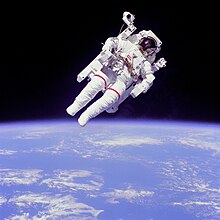| Revision as of 19:33, 29 October 2007 editRemember (talk | contribs)Autopatrolled, Extended confirmed users, Pending changes reviewers, Rollbackers18,673 edits →External links: add footer← Previous edit | Revision as of 22:51, 14 November 2007 edit undo71.61.250.20 (talk) →External linksNext edit → | ||
| Line 102: | Line 102: | ||
| ] | ] | ||
| ] | ] | ||
| Bruce McCanless is the first astornot that was on the moon | |||
| Chelsa O. | |||
Revision as of 22:51, 14 November 2007
| Bruce McCandless II | |
|---|---|
 | |
| Nationality | American |
| Occupation(s) | Engineer,Naval Pilot |
| Space career | |
| Astronaut | |
| Rank | Captain, USN |
| Time in space | 13d 00h 31m |
| Selection | 1966 NASA Group |
| Missions | STS-41-B, STS-31 |
| Mission insignia | File:STS-41-B patch.jpgFile:Sts-31-patch.jpg |

Captain Bruce McCandless II (born June 8, 1937 in Boston, Massachusetts) is a former naval aviator with the United States Navy and NASA astronaut. In the first of his two space shuttle missions he made the first untethered, free flight using the Manned Maneuvering Unit (pictured below).
Education
McCandless is the son of Bruce McCandless, a decorated United States Navy hero from World War II. He graduated from Woodrow Wilson Senior High School, Long Beach, California. In 1958 he received a bachelor of science degree from the United States Naval Academy, followed by a master of science degree in Electrical Engineering from Stanford University in 1965. In 1987 he received a Master of Business Administration degree from the University of Houston-Clear Lake.
U.S. Navy
McCandless graduated second in a class of 899 from the Naval Academy (Class of 1958), and subsequently received flight training from the Naval Aviation Training Command at bases in Pensacola, Florida, and Kingsville, Texas.
In March 1960 he was designated a naval aviator and proceeded to NAS Key West, for weapons system and carrier landing training in the F-6A Skyray.
Between December 1960 and February 1964 he was assigned to Fighter Squadron 102 (VF-102), flying the Skyray and the F-4B Phantom II. He saw duty aboard USS Forrestal and USS Enterprise, including the latter's participation in the Cuban Missile Crisis.
For three months in early 1964, he was an instrument flight instructor in Attack Squadron 43 (VA-43) at NAS Oceana, and then reported to the Naval Reserve Officer Training Corps Unit at Stanford University for graduate studies in electrical engineering.
During naval service he gained flying proficiency in the T-33B Shootingstar, T-38A Talon, F-4B Phantom II, F-6A Skyray, F-11 Tiger, TF-9J Cougar, T-1 Seastar, and T-34B Mentor airplane, and the Bell 47G helicopter. He logged more than 5,200 hours flying time—5,000 hours in jet aircraft.
NASA
McCandless was one of the 19 astronauts selected by NASA in April 1966. He was a member of the astronaut support crew for the Apollo 14 mission, served as CapCom when Neil Armstrong first set his foot on the moon and was backup pilot for the first manned Skylab mission (SL-1/SL-2). He was a co-investigator on the M-509 astronaut maneuvering unit experiment which was flown in the Skylab Program, and collaborated on the development of the Manned Maneuvering Unit (MMU) used during Shuttle EVAs.
He was responsible for crew inputs to the development of hardware and procedures for the Inertial Upper Stage (IUS), Space Telescope, the Solar Maximum Repair Mission, and the Space Station Program.
McCandless logged over 312 hours in space, including 4 hours of MMU flight time. He flew as a mission specialist on STS-41-B and STS-31.
STS-41-B
Challenger launched from Kennedy Space Center, Florida, on February 3, 1984. The flight deployed two communications satellites, and flight-tested rendezvous sensors and computer programs for the first time.
This mission marked the first checkout of the Manned Maneuvering Unit (MMU) and Manipulator Foot Restraint (MFR). McCandless made the first, untethered, free flight on each of the two MMUs carried on board.
After eight days in orbit, Challenger made the first landing on the runway at Kennedy Space Center on February 11, 1984.
STS-31
On this five-day Discovery flight, launched on April 24, 1990 from the Kennedy Space Center in Florida, the crew deployed the Hubble Space Telescope from their record-setting altitude of 380 miles (612 km).
Discovery landed at Edwards Air Force Base, California, on April 29, 1990.
Honors
- Legion of Merit (1988)
- Department of Defense Distinguished Service Medal (1985)
- National Defense Service Medal
- American Expeditionary Service Medal
- NASA Exceptional Service Medal (1974)
- American Astronautical Society Victor A. Prather Award (1975,1985)
- NASA Space Flight Medal (1984)
- NASA Exceptional Engineering Achievement Medal (1985)
- National Aeronautic Association Collier Trophy (1985)
- Smithsonian Institution National Air and Space Museum Trophy (1985).
He was awarded one patent for the design of a tool tethering system that is currently used during Shuttle spacewalks.
Organizations
Member of:
- U.S. Naval Academy Alumni Association (Class of 1958)
- U.S. Naval Institute
- Institute of Electrical & Electronic Engineers
- American Institute for Aeronautics and Astronautics
- Association for Computing Machinery
- National Audubon Society
He is a fellow of the American Astronautical Society and former president of the Houston Audubon Society.
Personal
McCandless married Bernice Doyle, and the couple have two grown children. His recreational interests include electronics, photography, scuba diving, and flying. He also enjoys cross country skiing.
External links
- NASA biography (from which this article is derived)
- Spacefacts biography of Bruce McCandless
Template:Astronaut Group 5 Footer Bruce McCanless is the first astornot that was on the moon Chelsa O.
Categories: